Paris, BnF, lat. 7900A
A manuscript full of classroom classics1
This late ninth- or early tenth-century manuscript was made in Northern Italy, perhaps in Milan. It is a large book, consisting of four parts: the Six Comedies of Terence (f. 1r-26v); works of Horace (f. 27r-56v); Lucan’s Pharsalia and Juvenal’s Satyres (f. 57r-111v); and Martianus Capella’s De nuptiis Philologiae et Mercurii with the large commentary tradition attributed to Remigius of Auxerre (f. 112r-155v). All the texts assembled in this codex are provided with ample commentary, written roughly contemporary with the main text. Martianus’s De nuptiis has a particularly rich commentary: the tradition attributed to Remigius, who compiled many commentaries by collecting and collating earlier traditions and merging them into a new one. The pages are filled to the brim with text in the margins. The liberal arts are illustrated at the beginning of each chapter with pen drawings.
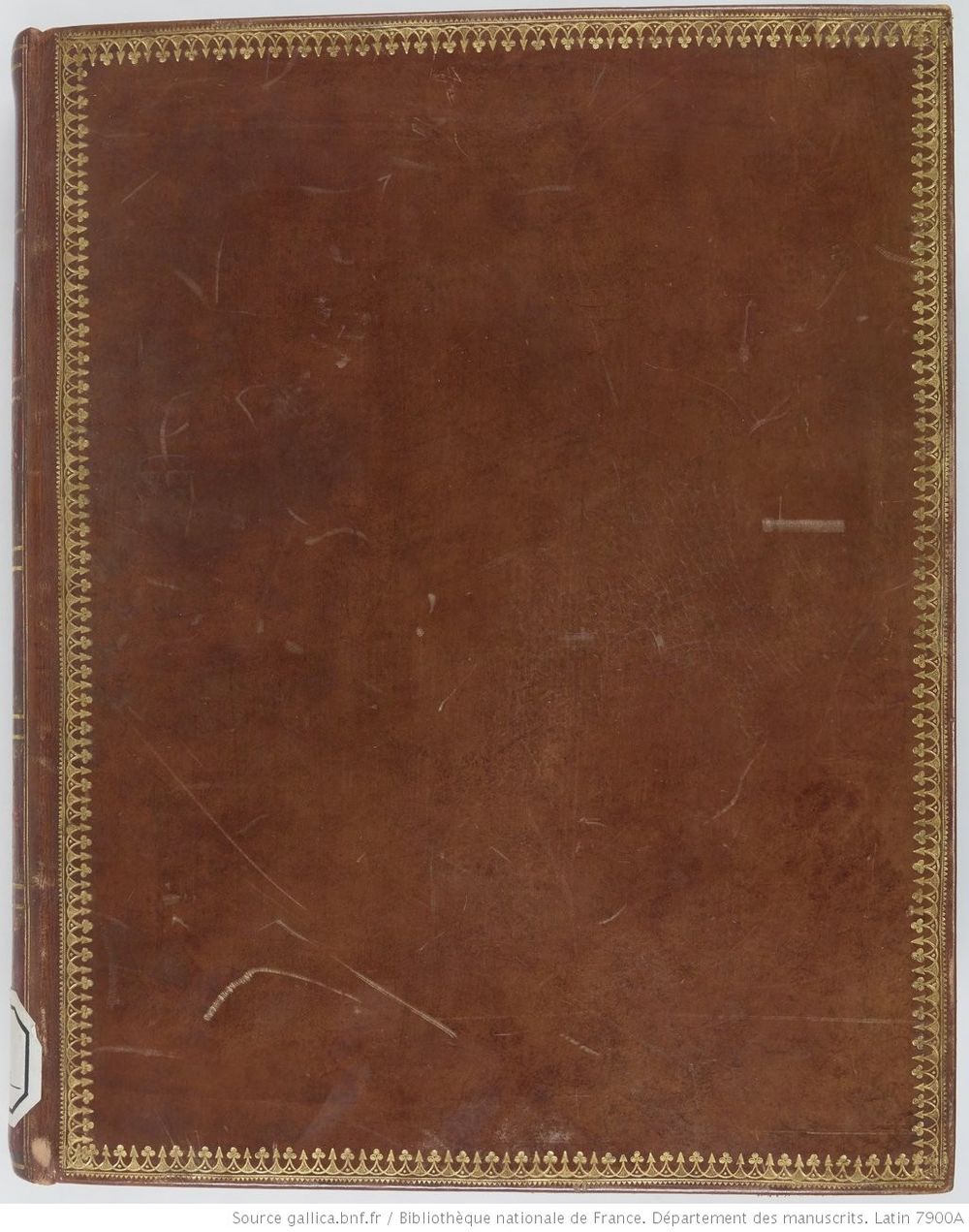
https://gallica.bnf.fr/ark:/12148/btv1b10546779x
Mixed Contents
The contents of this book are a collection of texts that were typically used in schools, for an advanced introduction into the liberal arts and specifically the arts of language: plays by Terence, poetry by Horace and Lucan, Roman history and moral lessons by Lucan, an encyclopedia of the seven liberal arts by Martianus. The book was composed in Northern Italy, where the tradition of studying the classics in the medieval classroom was strong. On fol. 27r Horace’s poetic works begin with a beautiful author’s portrait in the initial. On this page we see the main text, an introduction (accessus) to the author, a commentary in the right margin ánd extra notes in the left margin. A very full page indeed!



https://gallica.bnf.fr/ark:/12148/btv1b10546779x

https://gallica.bnf.fr/ark:/12148/btv1b10546779x
In spite of the fact that the margins are so full, the users of this manuscript still felt that they ran out of space to add material, and added narrow slips in between the pages to get even more material into this collection.


https://gallica.bnf.fr/ark:/12148/btv1b10546779x
In some parts one can see that the parchment used for this manuscript was not of the best quality: the natural edges of the skin are visible as the edges of the page. This is illustrated here with fol. 116. From the fact that the text carefully follows the curve at the edge of the page we can conclude that the page was not damaged, but that a sheet was used even when it did not reach the full measurement of the quire.

https://gallica.bnf.fr/ark:/12148/btv1b10546779x
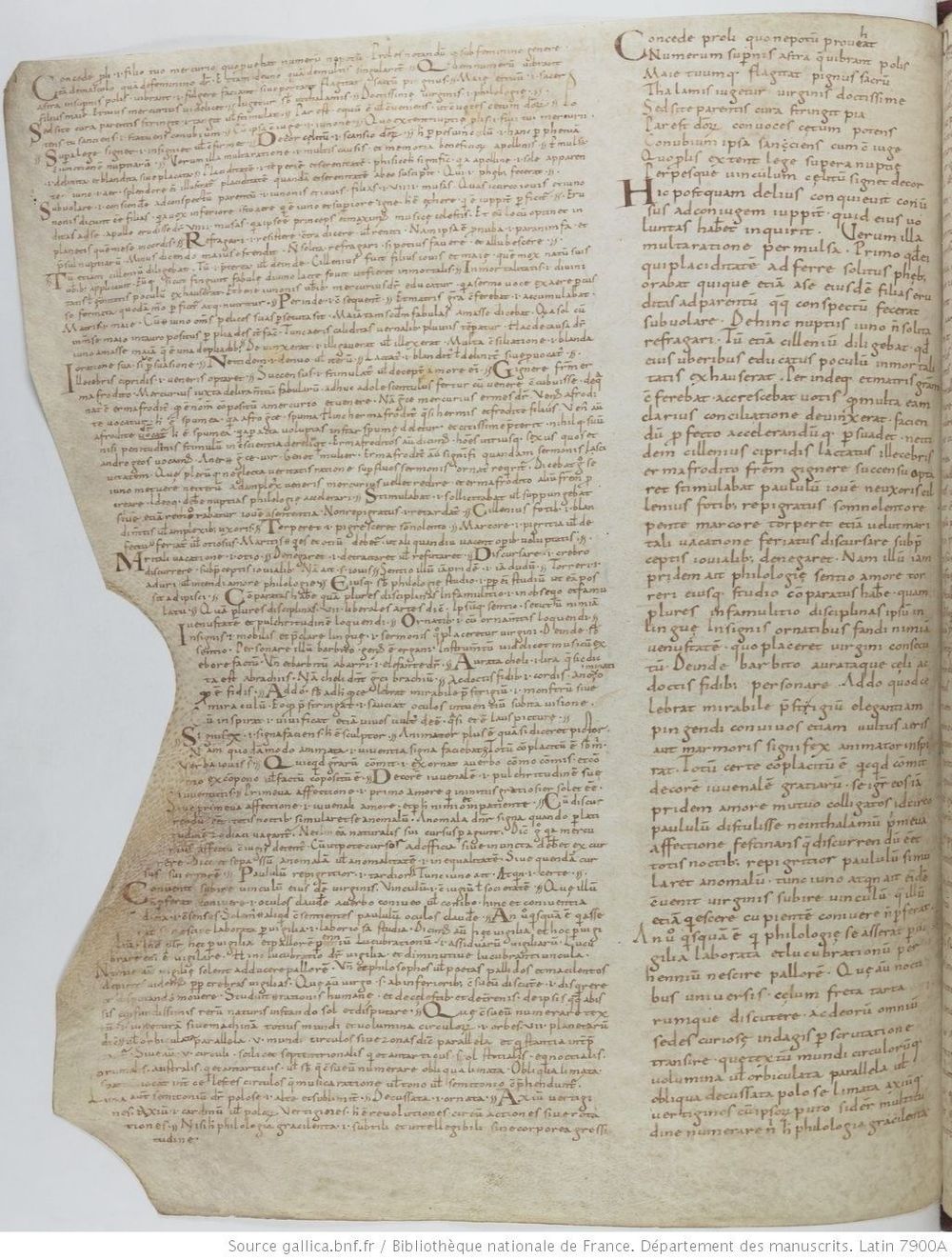
https://gallica.bnf.fr/ark:/12148/btv1b10546779x
Most of this book, in fact, was written on re-used parchment, as a palimpsest: parchment was already used for a text, but then scraped clean to make it usable again for a new text. In many of the pages the scraping or washing clean of the parchment left clear traces: the text that was originally on the page is still faintly visible, or the pages have been so rigorously scraped that it has become very thin. The scraping sometimes even caused holes in the parchment. The underlying text of parts of this manuscript has been identified: it was an abridged version of Pseudo-Quintilian’s Declamationes XIX maiores.2


https://gallica.bnf.fr/ark:/12148/btv1b10546779x
In more recent times, a chemical substance (re-agent) was applied to the page to make the underlying text visible. This did help initially, but it left ugly, permanent damage as the chemicals continued to react with the parchment and ink.
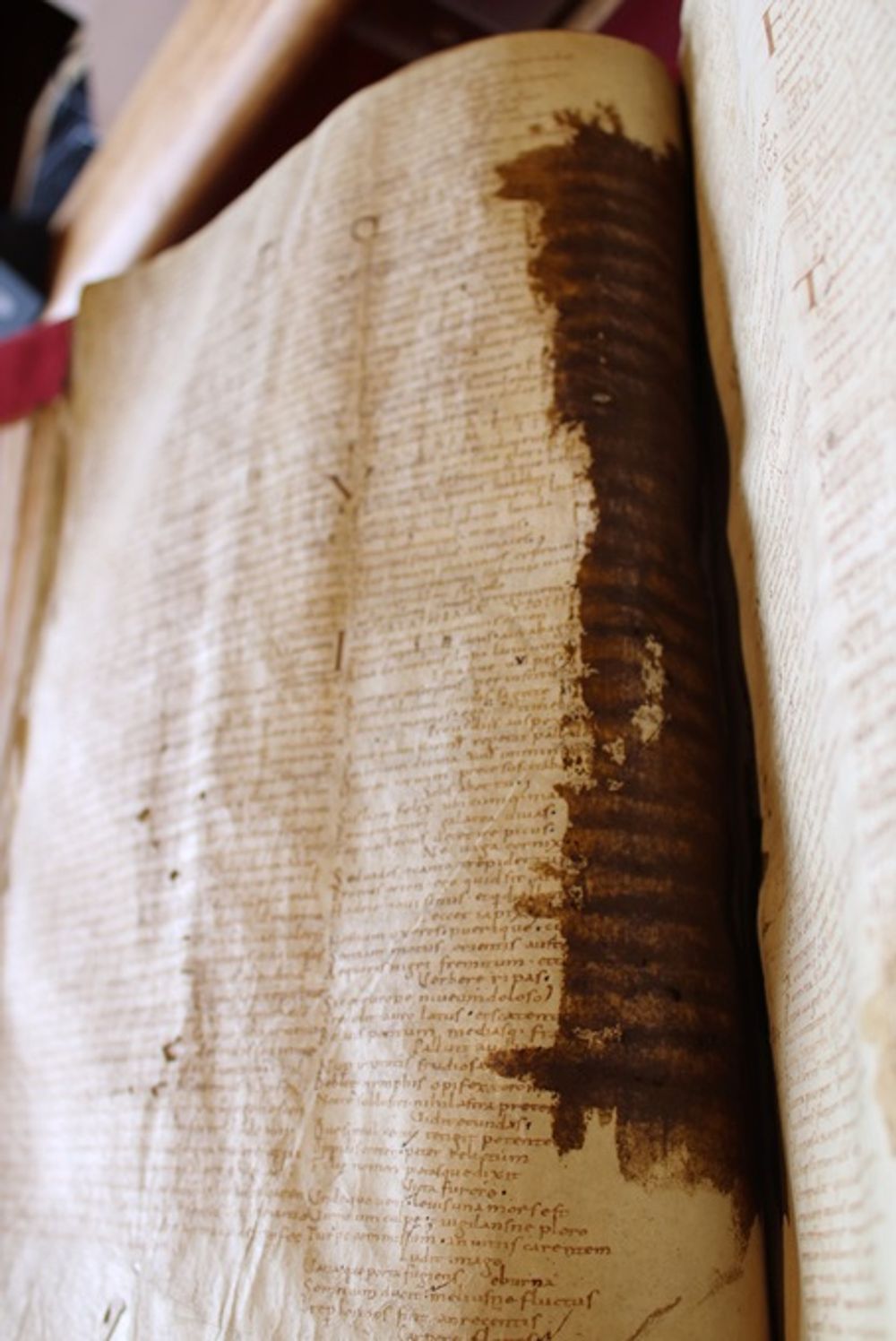

https://gallica.bnf.fr/ark:/12148/btv1b10546779x
The book is thus, although quite large, humble in appearance, with very full pages and parchment that is not of a very high quality. Yet it does feature some simple but fanciful initials: here an E made with two peacocks, which is used to mark the beginning of a new section in Juvenal’s Satires on fol. 109v. Juvenal’s Satires were a common school text in the Middle Ages: with this text students could practice their poetic metres (hexameters), learn about Roman history and were presented with moral lessons about society, thus killing three birds with one stone.

https://gallica.bnf.fr/ark:/12148/btv1b10546779x
Here you see the opening of Martianus Capella’s De nuptiis on fol. 112r. Nota bene: the main text of Martianus Capella occupies the small column on the left. Its beginning is missing because the page is damaged. Perhaps the text started with a decorated initial that was cut out by a later dealer in manuscripts or manuscript’s pages. The wide column on the right is the commentary of Remigius. The commentary has become a solid block of text instead of a series of notes spread in the margin. At the top of the page it begins with an introduction to the work and its author: “Titulus iste quattuor nomina dat auctori suo” (“The title gives four names to the author…”). Such an introduction was common practice at the start of a commentary.


Simple decorated initials with motifs from the animal world (f. 120v) mark the beginning of a new book, both for the main text (narrow column on the right) and for the commentary (wide column on the left). It is noteworthy that the pages are so full and the lay-out so cramped, that there is hardly a difference in the size of the letters used for the two categories of text. This is an unusual feature: generally, the main text used a larger letter and the commentary a smaller one.

https://gallica.bnf.fr/ark:/12148/btv1b10546779x
On this page, the book on Grammar starts with a fanciful initial R (fol. 128r). A dragon bearing a remarkably strong resemblance to a crocodile is stabbed with a spear. Again, one can see here that the commentary text (column on the right) surpasses the main text (column on the left) in length considerably. A stepped line is used to clarify the boundary between the two texts.
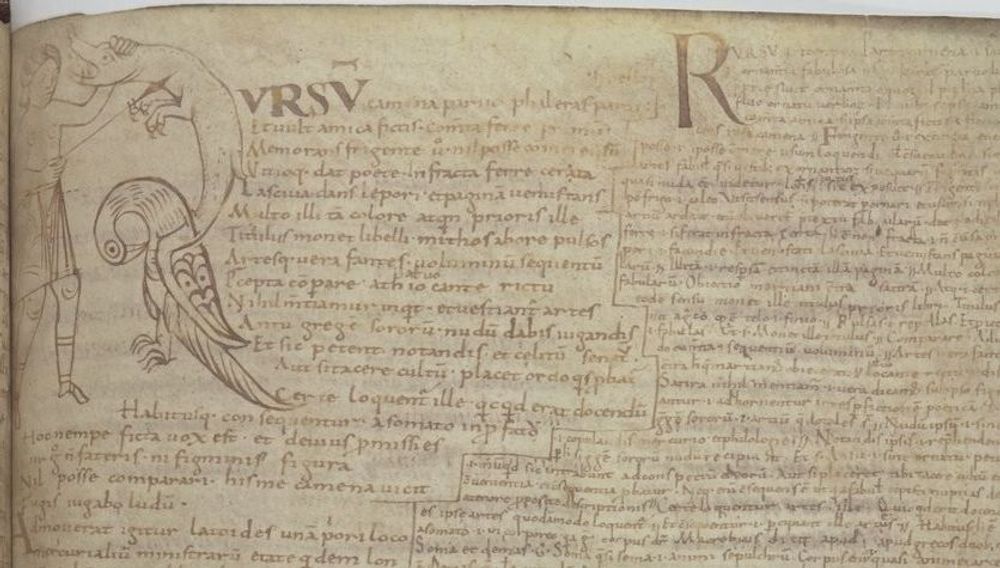
https://gallica.bnf.fr/ark:/12148/btv1b10546779x
Portraits
This manuscript is particularly famous for its charming portraits of the liberal arts, depicted as wise ladies just as in Martianus Capella’s narrative. Here we see fol. 127v: a portrait of ‘Lady Grammar’ teaching a class full of pupils. The boys in the front row have their writing tablets ready for use. Grammar was the discipline of the trivium (the three arts of language of the seven liberal arts) which was taught at the basic level of education: in monasteries and cathedral schools, children were taught to read and write Latin, which was of crucial importance because it was the language of the bible, the liturgy and the church.
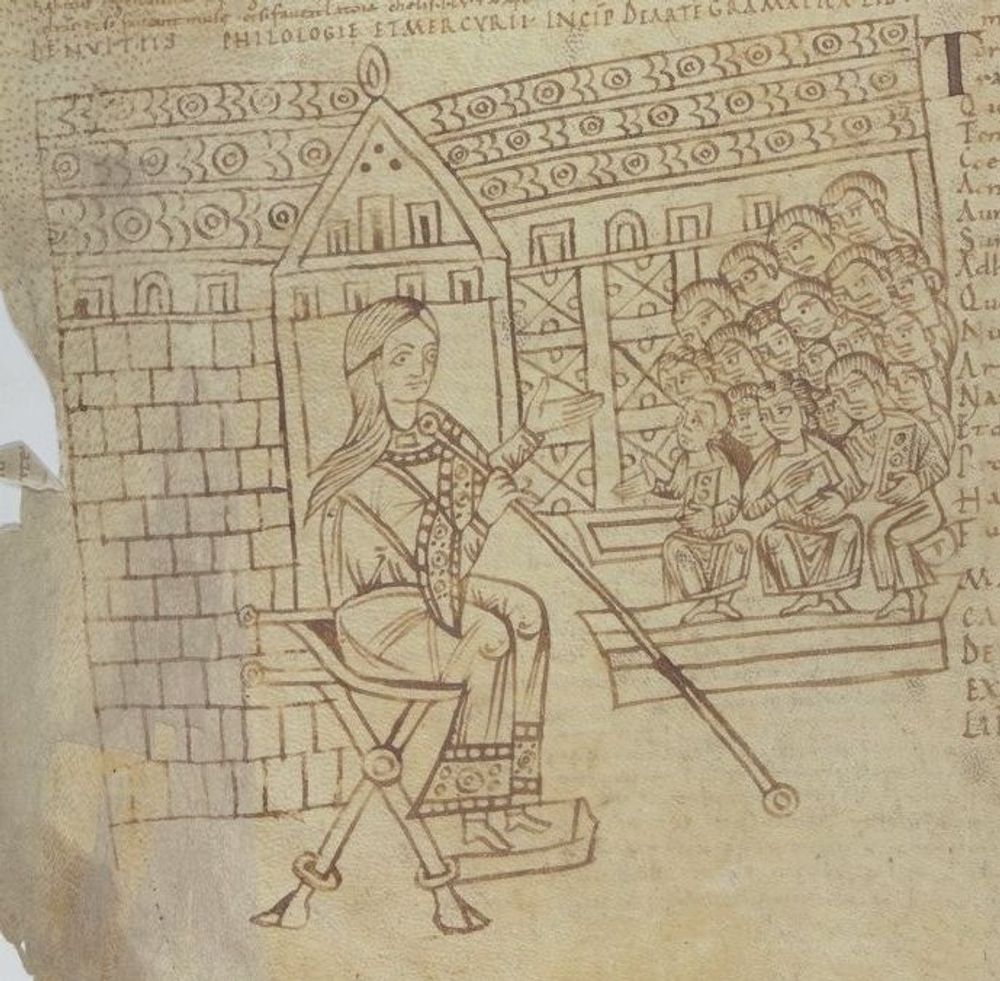
https://gallica.bnf.fr/ark:/12148/btv1b10546779x
On fol. 132v a full page illustration features a portrait of lady Dialectica (who speaks about her discipline in book IV of De nuptiis). Two students tentatively approach Lady Dialectica, who is armed with a hook (to reel in the two students on the right) and has snakes coming out of her sleeve (with which she attacks her opponents). She is a dangerous lady.
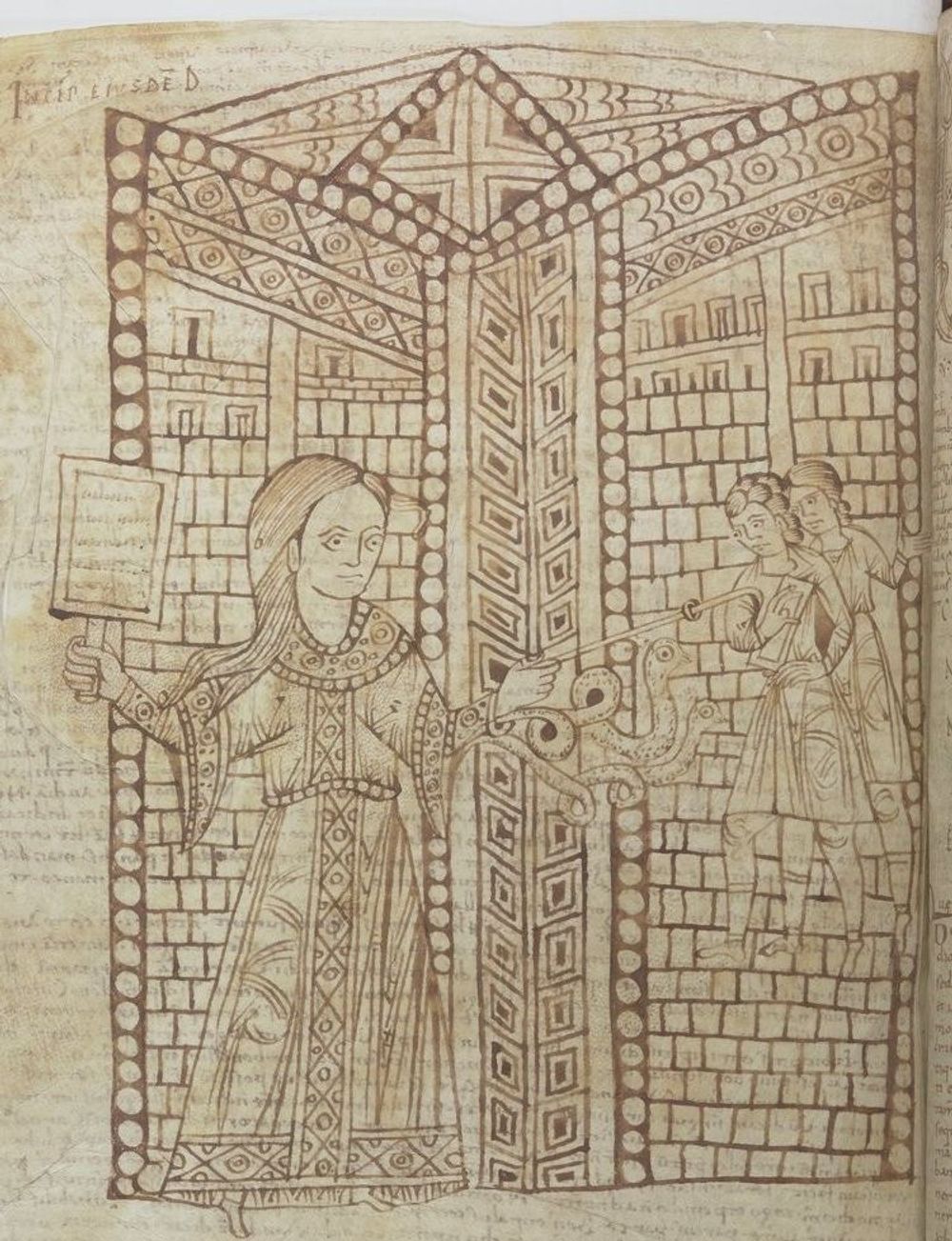
https://gallica.bnf.fr/ark:/12148/btv1b10546779x
On fol. 140v, Lady Rhetoric is depicted, reading from a long and narrow book. Two arts of the quadrivium are also portraited: Lady Astronomy (fol. 151v) and Lady Music (fol. 153v). Astronomy is pointing at a globe with stars, Music is accompanied by two musicians playing a single and a double horn.
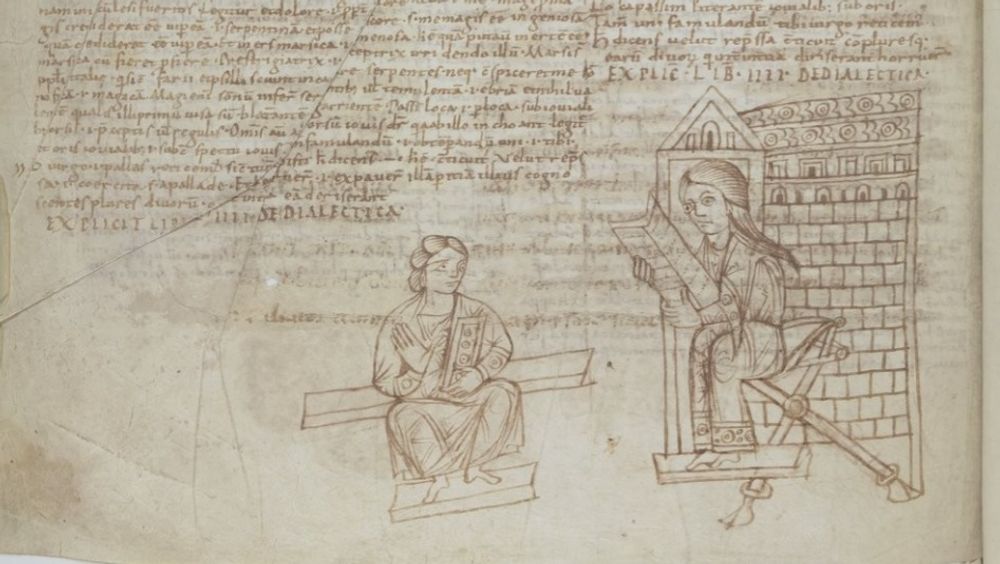



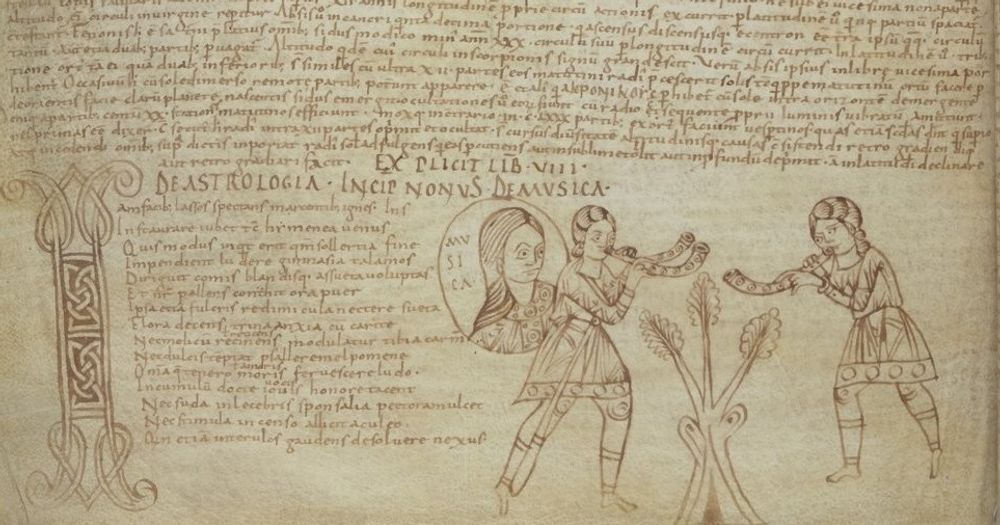

https://gallica.bnf.fr/ark:/12148/btv1b10546779x
https://gallica.bnf.fr/ark:/12148/btv1b10546779x
https://gallica.bnf.fr/ark:/12148/btv1b10546779x
Sources used for this contribution:
- Description and bibliography on the site Archives et manuscrits of the Bibliothèque Nationale de France: https://archivesetmanuscrits.bnf.fr/ark:/12148/cc94410h
- Claudine A. Chavannes-Mazel and Margaret M. Smith, Medieval manuscripts of the Latin Classics: production and use, Los Altos Hills, CA: Anderson-Lovelace/London: The Red Gull Press, 1996.
- F. Ronconi, “Il codice palinsesto Paris. Lat. 7900A: una nuova ispezione della scriptio inferior”, in Approches de la Troisième Sophistique, Bruxelles, 2006 (Latomus), p. 585-588.
Contribution by Mariken Teeuwen.
Cite as, Mariken Teeuwen, “Paris, BnF, lat. 7900A”, The art of reasoning in medieval manuscripts (Dec 2020), https://art-of-reasoning.huygens.knaw.nl/lat7900a. ↑
Ronconi, “Il codice palinsesto Paris. Lat. 7900A”. ↑


